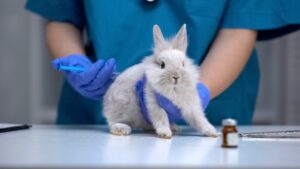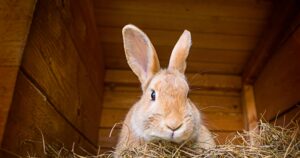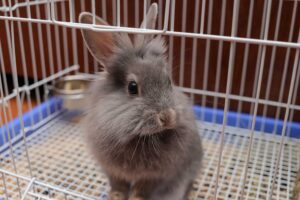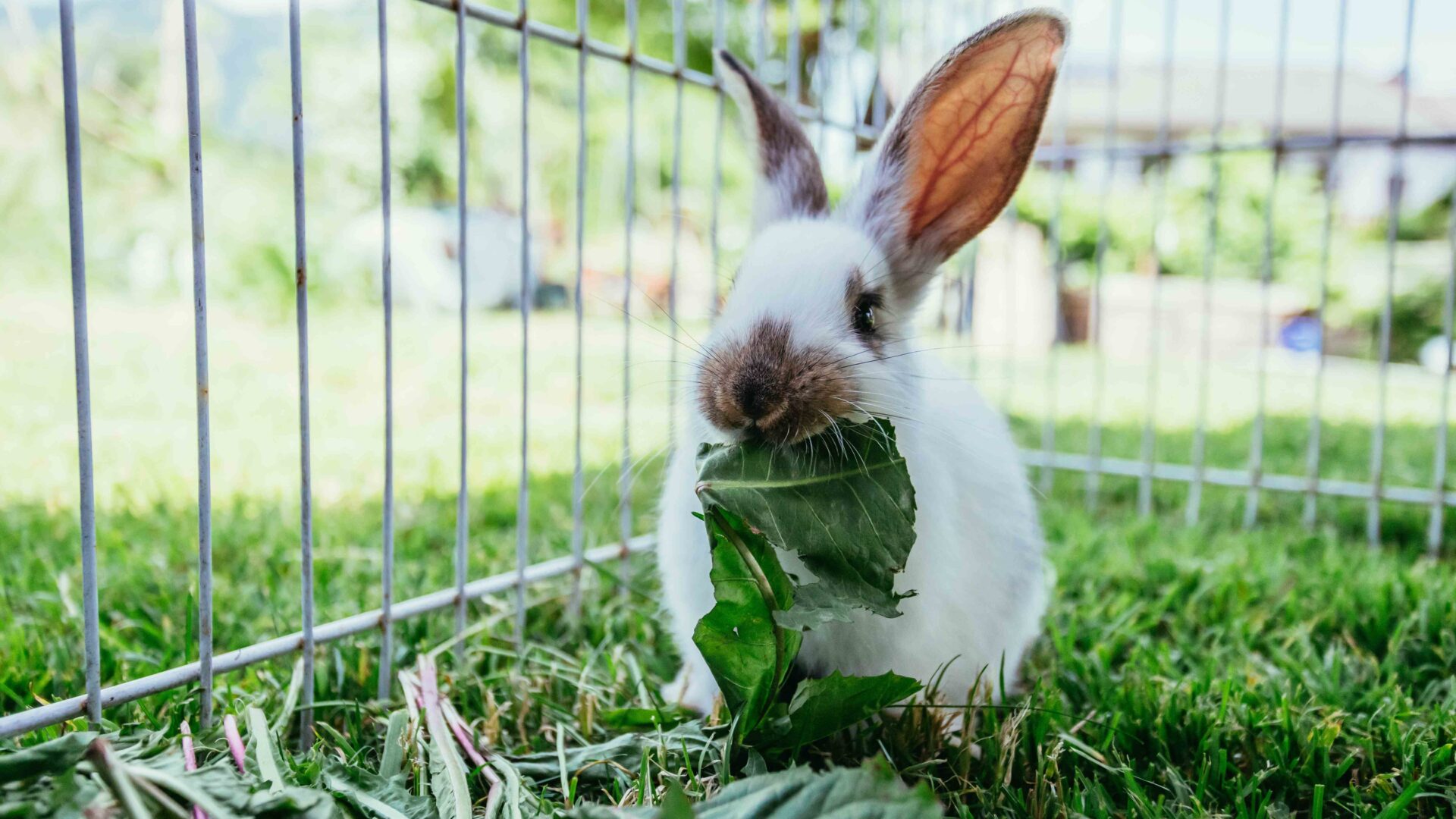Updated: 15/01/25
Flystrike is caused by flies laying eggs on rabbits, which hatch into maggots that can feed on a rabbit’s skin and underlying tissues and can cause severe injury to indoor and outdoor rabbits. Rabbits with underlying health issues are at greatest risk.
Keeping your rabbit’s fur clean, checking for open wounds, cleaning their housing regularly and removing fresh, uneaten food will help to protect your rabbit from flystrike. You can speak to your vet about your rabbit’s risk of fly strike and the preventative products that are available.
In warm weather, check your rabbit twice a day for signs of fly eggs or maggots, focusing on their bottom, above their tail and around their face.
For further support and advice, please contact your local vet practice.
On this page:
- What is flystrike in rabbits?
- Why does flystrike make rabbits so seriously ill?
- What attracts flies to lay eggs on rabbits?
- What time of year does flystrike happen?
- How do I check my rabbit for signs of flystrike?
- What are the symptoms of flystrike in rabbits?
- How to prevent flystrike in rabbits
- Can indoor rabbits get flystrike?
- I think my rabbit has flystrike! What is the treatment?
What is flystrike in rabbits?
Flystrike (also called ‘myiasis’) is a potentially life-threatening condition in rabbits that is caused when blowflies (green and blue bottles) lay their eggs on a rabbit’s fur.
The maggots that hatch eat away at the rabbits’ skin and underlying tissues, often causing severe damage.
Very sadly, rabbits are seen at the vets every year with flystrike, and many are too poorly to be saved.
Why does flystrike make rabbits so seriously ill?
Once a fly has laid eggs on a rabbit, the eggs quickly hatch into maggots.
These maggots have a ravenous appetite and grow rapidly by feeding on the rabbit’s skin and underlying tissues.
The longer they are left untreated, the more extensive the damage they cause and sometimes, when this damage is too bad to treat, putting the rabbit to sleep is the kindest option.
This is why preventing flystrike and catching it early when it does happen is absolutely vital for a rabbit’s survival.
What attracts flies to lay eggs on rabbits?
Flies are attracted to certain smells such as urine, faeces and blood.
Overweight rabbits or those with softer faeces are at increased risk of poo sticking to their tail and bottom.
If your rabbit is not kept clean or has a silent health problem, such as dental disease or arthritis, which leaves them unable to clean their own bottom or move around, then they are at greater risk of flies laying eggs on them.
Any open wounds can also attract flies, and so extra care should be taken if your rabbit is recovering from an injury.
Regular health checks with a vet, such as the one performed at your rabbit’s annual vaccination visit, can help to spot early signs of dental disease, arthritis or pain.
You can find out more about annual vaccination here.

What time of year does flystrike happen?
As vets, we see flystrike more commonly during the warmer months, especially summer, but it can happen all year round.
You can speak to your vet about your rabbit’s risk of fly strike and the preventative products that are available.
How do I check my rabbit for signs of flystrike?
It is very important to check rabbits all over, twice a day, during the warmer months, for signs of fly eggs or maggots.
Pay special attention to checking around their backend, above their tail and around their face. In the early stages, fly eggs and maggots are not always easy to see, so be sure to check carefully.
Fly eggs are visible with the naked eye but are tiny (1mm to 2mm in length) and are shaped and coloured like a tiny grain of rice.
Maggots look like clear to yellowy-pink grubs, and can vary in size from 2mm up to about 2 cm in length as they grow.
As we discussed earlier in this article, flies are attracted to urine, faeces and blood, so ensure your rabbit is clean and not matted around their bottom and check for wounds.
If you find that your rabbit has got matted around their bottom and you cannot easily clean the area, contact your local vet for support, as rabbit skin is very delicate and can easily be caught or torn when removing matts or clumps of dried on poo.
Poo and wee in the fur around your rabbit’s bottom is never normal. If this is something you are noticing, then take your rabbit to see a vet, as this usually indicates your rabbit has an underlying health or diet issue.
It’s also worth checking to see whether your rabbit is eating their caecotrophs (the soft, slimy poos they pass overnight). If not, let your vet know, as this may also indicate a health problem.
What are the symptoms of flystrike in rabbits?
- Quiet or withdrawn behaviour.
- Wet or patchy fur around the backend.
- Hair loss, sometimes with open wounds.
- Reduction or absence of appetite.
- Unpleasant smell.
- Visible maggots in the coat.
- Collapse.

How to prevent flystrike in rabbits
Taking your rabbit for regular health checks is an important way to protect your rabbit from flystrike by detecting and treating health issues early.
Rabbits who are unable to groom themselves, weeing excessively, producing sloppy poos or are arthritic (have stiff joints) should be seen by a vet, both to manage the problem but also to reduce the risk of flystrike.
For rabbits that are overweight, a weight reduction program guided by your veterinary team will bring several health benefits, but will also mean they are more mobile and better able to clean themselves, reducing the risk of flystrike.
Fly strips hung near your rabbit’s housing may be helpful to reduce the flies.
However, treating at-risk rabbits with an appropriate protective product between spring and autumn is the most effective way of keeping them safe.
You can speak to your vet for further guidance on this and can ask for help applying the product if needed.
It is also important to check your rabbit’s fur is clean and free of injuries, make sure their housing is cleaned out regularly and clean up any fresh, uneaten food to reduce the risk of attracting flies in the first place.
Having adequately sized accommodation with a litter tray will also help to prevent flystrike and allow rabbits to avoid resting where they toilet. The Rabbit Welfare Association and Fund recommends a pair of rabbits should have the minimum area of 3m x 2m x 1m high. Many rabbit hutches sold in the UK do not meet these minimum recommendations.
Can indoor rabbits get flystrike?
All rabbits, indoor and out, are at risk of flystrike.
Unfortunately, it is still possible for flies to come inside via open windows and doors, so it is much better to be safe than sorry, still do regular checks and consider using a preventative product if needed.

I think my rabbit has flystrike! What is the treatment?
This is an emergency, and you should contact a vet straight away for treatment.
Stay as calm as you can and try not to stress your rabbit as they are often more poorly than they outwardly show.
Despite the temptation, do not bathe your rabbit or spray anything on them, you are better to promptly get them to a vet.
Wetting their fur risks dropping their body temperature and it often makes it more difficult for us to clip and assess them when they arrive at the veterinary practice.
When you arrive for your appointment, the vet will do a full assessment and advise on the best course of action.
Spotting flystrike early and seeking veterinary attention straight away gives your rabbit the best chance of survival.
If you have spotted signs of maggots on your rabbit or are worried your rabbit has flystrike, then contact your vet straight away for help.
Useful resources:
- RWAF – Flystrike in rabbits: https://rabbitwelfare.co.uk/flystrike-in-rabbits/
With many thanks to Deborah Stafford MA VetMB MRCVS GPCertExAP for contributing to this content.
Did you find this article useful? Why not take a look at…

